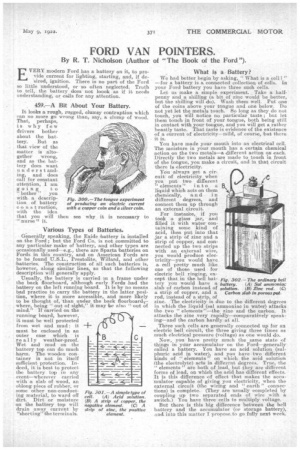FORD VAN
Page 29

If you've noticed an error in this article please click here to report it so we can fix it.
POINTERS.
By R. T. Nicholson (Author of "The Book of the Ford ").
EVERY modern Ford has a battery on it, to provide current for lighting, starting, and, if desired, ignition. There is no part of the Ford so little understood, or so often neglected. Truth to tell, the battery does not book as if it needs understanding, or calls for any attention.
459.—A Bit About Your Battery.
It looks a rough, rugged, clumsy contraption which can no more go wrong than, say, a clump of wood. That, perhaps, is why few drivers bother about the battery. But as that view of the matter is altogether wrong, and as the battery does want understanding, and does call for constant attention, I am
going to " bother" you with a description of battery eonst ruction, with the idea that you will then see why. it is necessary to " nurse " it.
Fig. 300.—The longue experiment of producing an electric current with a copper coin and a sillier coin.
Various Types of Batteries.
Generally speaking, the Exide battery is installed on the Ford ; but the Ford Co. is not committed to any particular make of battery, and other types are occasionally used—e.g., there are Sparta batteries on Fords in this country, and on American Fords are to be found U.S.L., Prestolite, Willard, and other batteries. The construction of all such batteries is, however, along similar lines, so that the following description will generally apply.
Usually, the battery is carried in a frame under the back floorboard, although early Fords had the battery on the left running board. It is by no means bad practice to carry the battery in the latter position, where it is more accessible, and more likely to be thought of, than under the back floorboar&— where, being " out of sight," it may he also "out of mind." If carried on the running board, however, it must be well protected front wet and mud : it must be enclosed in an outer case which is re ally weather-proof. Wet and mud on the battery top can do much harm. The wooden container it not in itself sufficient protection. Indeed, it is best to protect the battery top in any event—wherever carried with a slab of wood, an oblong piece of rubber, or
some other non-conductFig. 301.—A simple type of ing material, to ward off cell. (A) Acid solution. dirt. Dirt or moisture (9) A strip of copper, the on the battery top will negative element. (C) A drain away current by strip of zinc, the positive "shorting" the terminals. . element. What is a Battery?
We had better begin by asking, " What is a cell? " —for a battery is a connected collection of cells. In your Ford battery you have three such cells.
Let us make a simple experiment. Take a halfpenny and a shilling (a bit of zinc would be better, but the shilling will do). Wash them well. Put one of the coins above your tongue and one below. Do not yet let the metals touch. So long as they do not touch, you will notice no particular taste; but let them touch in front of your tongue, both being still in contact with your tongue, and you will get a rather beastly taste. That taste is evidence of the existence of a current of electricity—mild, of course, but there it is.
You have made your mouth into an electrical cell. The moisture in your mouth has a certain chemical action on the two metals—a different action on each. Directly the two metals are made to touch in front of the tongue, you make a circuit, and in that circuit there is electricity.
You always get a circuit of electricity when yon put two different elements" in to a liquid which acts on them chemically, and i n different degrees, and cornices them up through an external circuit.
For instan'oe, if you took a glass jar, and . filled it with water containing some kind of acid, then put into that jar a strip of zinc and a strip of copper, and connected up the two strips with an external wire, you would produce electricity—you would have .a cell pretty much like one of those used for
electric bell ringing, ex. cept that, in the bell batFig. 302.— The ordinary bell tery you would have a battery. (A) Sal ammoniac slab of carbon instead of solution. (B) Zinc rod. (C) a strip of copper, and a Carbon slab in porous pot. rod, instead of a strip, of
zinc. The electricity is due to the different degrees in which the liquid (sal ammoniac in water) attacks the two " elements' —the zinc, and the carbon. It attacks the zinc very rapidly—comparatively speaking—and the carbon hardly at all.
Three such cells are generally .connected up for an electric bell circuit, the three giving three times as much electrical pressure (voltage) as one would do.
Now, you have pretty much the same state of things in yOur accumulator on the Ford—generally called a battery. You have an acid solution (sulphuric acid in water), and you have two different kinds of "elements " on which the acid solution (the electrolyte) sets in different degrees. True, the " elements " are both of lead, but they are different forms of lead, on which the acid has different effects. It is this difference of effect that makes the accumulator capable of giving, you electricity, when the external circuit (the wiring and " earth" connections) is complete. (They are usually completed by coupling up two separated ends of wire with a switch.) You have three cells to multiply voltage.
But there is this big difference between the hell battery and the accumulator (or storage battery), and. into this matter I propose_to go fully next week.




































